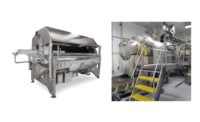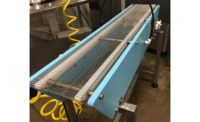Dry, Cool…and Clean!
by Richard Mitchell
Dehumidification, air-handling, and cooling-systems technology providers offer a range of products and services to help meat and poultry plants achieve greatness in food safety and product quality.
In creating environments that are most conducive to food safety and extending the shelf life of meat and poultry, packers and processors would perhaps best be served by a guiding mantra of “dry, cool, and clean.”
By keeping the work place free of moisture, humidity, and heat, plant operators are eliminating the elements that best promote the growth of bacteria. Ensuring that the outside air is filtered as it is drawn into food-handling areas is another important step for reducing potential contaminants.
With those ends in mind, packers and processors are leveraging increasingly advanced dehumidification, air-handling, and cooling systems to create and maintain optimal operating conditions.
“The technology makes it easier for sanitation to do its job and then keep the rooms dry,” says Dave Kramer, vice president of Cincinnati-based Sara Lee Foods. “The dryer we can get these rooms, the better we are in controlling the environment.”
Sara Lee Foods has installed dehumidification, filtration, and air-handling technologies in its 15 U.S. plants from equipment suppliers that include Munters Corp. and York Refrigeration. The company’s rooftop units incorporate a variety of enhanced functionalities within a single system.
Desiccant dehumidification equipment helps to prevent the food contamination that results from condensation. In many instances, water that is used to sanitize work areas will evaporate and then condense on ceilings, walls, and equipment. That moisture, a potential breeding ground for bacteria, becomes a contamination threat to meat and poultry.
Processing and packing facilities are ripe locations for condensation because plants typically operate at temperatures of below 50Þ F. Since colder air holds less moisture, water is prone to condense on equipment and other surfaces.
Prior to incorporating desiccant systems, many plant operators hired “wiper crews” to immediately remove condensation droplets or else have employees hang plastic sheeting from ceilings to create a barrier above the food areas. Both procedures, however, often resulted in increased downtime and enhanced labor and material costs.
“Humidity-control systems can now stop condensation from forming, while also reducing the frequency that coils on cooling equipment have to be defrosted. All of this results in reduced sanitation expenses,” says Joe Martino, business development engineer with Munters Corp., an Amesbury, MA-based manufacturer of dehumidification technologies.
Munters’ newer technology includes its Condensation Control System (CCS), a dehumidifying unit that integrates a desiccant — a material that attracts and holds water vapor — with a refrigeration system.
Because no metal parts within the CCS extend to the warmer outside air, condensation cannot form on the exterior of the system. Triple-sloped drain pans within various sections of the CCS immediately remove the water that drips off cooling coils, eliminating a possible source of bacteria.
Claxton Poultry, a Claxton, GA-based processor, is using Munters’ Condensation Control System to remove moisture that results from its sanitation activities and different weather conditions.
“Prior to installing the technology, we knew there would be a problem with condensation at the plant if there was a thunderstorm or fog was present in the morning,” says John Siebel, Claxton Poultry’s complex manager. “Now there is no longer an issue with the weather affecting our operations.”
The Condensation Control System also has helped reduce bacteria counts and defrost cycles, while enhancing worker comfort, which is resulting in less employee turnover, reduced sick time, and greater productivity, he notes.
Air filtration systems that sanitize and pressurize work areas also are becoming increasingly important. The Hygienic Air-Handling technologies from the Dixon, IL-based ACUair division of York International, for instance, are designed to meet a plant’s cooling and dehumidification requirements, while also drawing in the optimal amount of outside air for pressurization.
By maintaining the correct pressure of filtered air within critical work areas, plant operators eliminate the risk that less-sanitized warmer air would be drawn into the processing space if a door opens. In addition to carrying bacteria, the unwanted air also could trigger condensation as it enters the cooler environment.
“Good air balance is paramount for an efficient and safe operation because you want to isolate your products and people from unwanted air and contaminants,” says Mark Burrows, product manager for York’s ACUair division. “And there are different degrees of pressure that must be maintained. A slaughterhouse should be under negative positive pressure so its air can’t flow to other spaces. Areas with ready-to-eat products, must have the most positive pressure.”
Sustaining proper room pressure, however, is becoming an increasingly demanding task as more meat and poultry processors lower their operating temperatures in an effort to further retard the growth of bacteria. Many plants now operate at 35Þ F — well below the common 45Þ F benchmark.
When temperatures are set lower, cooling coils within air-handling units need to be defrosted more frequently. Shutting down the systems for such maintenance, however, would derail the equipment’s pressurization functions.
To solve the dilemma, ACUair incorporated multiple coils within its equipment so the units can run continuously during the sequential defrosting of the components, Burrows says. That eliminated the need — and the large expense — for plants to operate redundant rooftop air-handling systems.
Some operators, are adding ultra-violet (UV) lights to their coiling apparatus. The UV rays are designed to kill particles as they flow through the cooling system.
Coil manufacturer Krack Corp., Addison, IL, offers the lights as an option in its Clean Air product line. Interest in the lights is increasing, says Tom Lemar, Krack Corp. director of sales.
Krack’s Clean Air unit also filters air entering work spaces, and it helps to ensure that rooms are properly pressurized, Lemar notes. An enhanced focus on plant hygiene by regulators and operators is leading processors to situate the equipment in more areas of the plant, he adds.
In order to enhance food safety and quality, it is vital that meat and poultry companies address all possible sources of contaminants within their facilities. And while technologies that improve air quality are becoming more effective, the need for vigilance remains.
“Workers give off contaminants, and the more traffic in plant, the greater the buildup,” says Ron Vallort, president of Ron Vallort and Associates Ltd., an Oak Brook, IL-based refrigeration and food-processing consultant.
Richard Mitchell is a freelance writer based in the Chicago area.
Technology sources participating in this article include:
- ACUair, York International, phone: (815) 288-1642, fax (815) 288-1409, e-mail mark.burrows@york.com, or visit www.york.com
- Krack Corp., phone (630) 629-7500, fax (630) 629-0168, e-mail ron_ariano@irco.com, or visit www.krack.com
- Munters Corp., phone (978) 241-1100 or (800) 843-5360, fax (978) 241-1263, e-mail dhinfo@munters.com, or visit www.muntersamerica.com
- Ron Vallort & Associates, phone (630) 393-7790 or fax (630) 734-3822


Report Abusive Comment